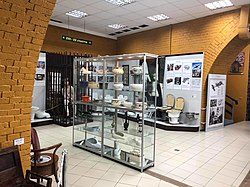
Vladimir I Sviatoslavich or Volodymyr I Sviatoslavych, nicknamed the Great, was Prince of Novgorod from 970 and Grand Prince of Kiev from 978 until his death in 1015. The Eastern Orthodox Church canonised him as Saint Vladimir.

A bidet is a bowl or receptacle designed to be sat upon in order to wash one's genitalia, perineum, inner buttocks, and anus. The modern variety has a plumbed-in water supply and a drainage opening, and is thus a plumbing fixture subject to local hygiene regulations. The bidet is designed to promote personal hygiene and is used after defecation, and before and after sexual intercourse. It can also be used to wash feet, with or without filling it up with water. In several European countries, a bidet is now required by law to be present in every bathroom containing a toilet bowl. It was originally located in the bedroom, near the chamber-pot and the marital bed, but in modern times is located near the toilet bowl in the bathroom. Fixtures that combine a toilet seat with a washing facility include the electronic bidet.
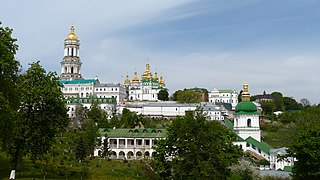
Kyiv is the capital and most populous city of Ukraine. It is in north-central Ukraine along the Dnieper River. As of 1 January 2022, its population was 2,952,301, making Kyiv the seventh-most populous city in Europe. Kyiv is an important industrial, scientific, educational, and cultural center in Eastern Europe. It is home to many high-tech industries, higher education institutions, and historical landmarks. The city has an extensive system of public transport and infrastructure, including the Kyiv Metro.
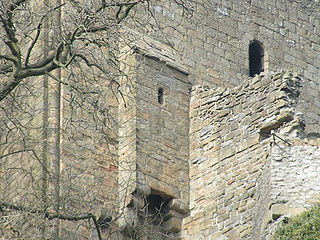
Garderobe is a historic term for a room in a medieval castle. The Oxford English Dictionary gives as its first meaning a store-room for valuables, but also acknowledges "by extension, a private room, a bed-chamber; also a privy".

Saint Sophia Cathedral in Kyiv, Ukraine, is an architectural monument of Kievan Rus'. The former cathedral is one of the city's best known landmarks and the first heritage site in Ukraine to be inscribed on the World Heritage List along with the Kyiv Cave Monastery complex. Aside from its main building, the cathedral includes an ensemble of supporting structures such as a bell tower and the House of Metropolitan. In 2011 the historic site was reassigned from the jurisdiction of the Ministry of Regional Development of Ukraine to the Ministry of Culture of Ukraine. One of the reasons for the move was that both Saint Sophia Cathedral and Kyiv Pechersk Lavra are recognized by the UNESCO World Heritage Program as one complex, while in Ukraine the two were governed by different government entities. It is currently a museum.
A souvenir , memento, keepsake, or token of remembrance is an object a person acquires for the memories the owner associates with it. A souvenir can be any object that can be collected or purchased and transported home by the traveler as a memento of a visit. The object itself may have intrinsic value, or be a symbol of experience. Without the owner's input, the symbolic meaning is lost and cannot be articulated.
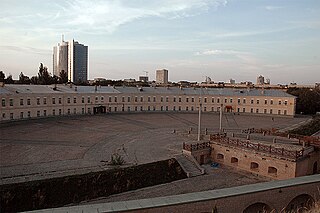
The Kyiv Fortress or Kiev Fortress is a historical and architectural monument complex of Russian fortifications in Kyiv, Ukraine built from the 17th through 19th centuries. Construction began after the 1654 Council in Pereiaslav, on the site of the already existing fortified monastery of Kyiv Pechersk Lavra. Located on the hills of the high right bank of the Dnieper, bounded on the north by the Klovsky ravine, on the south and west – by the slopes of the Lybid River valley.
The history of Kyiv (Kiev), officially begins when it was founded in 482, but the city may date back at least 2,000 years. Archaeologists have dated the oldest known settlement in the area to 25,000 BC. Initially a 6th-century Slavic settlement, it gradually acquired eminence as the center of East Slavic civilization. Kyiv's Golden Age as the capital of medieval Kievan Rus' came from 879 to 1240.
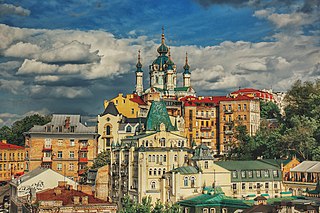
Andriivskyi Descent or Andrew's Descent is a historic descent connecting Kyiv's Upper Town neighborhood and the historically commercial Podil neighborhood. The street, often advertised by tour guides and operators as the "Montmartre of Kyiv", is a major tourist attraction of the city. It is included in the list of national landmarks by the government resolution. In addition, the street is also part of the Kyiv city historic reserve "Ancient Kyiv", while the St.Andrew's Church belongs to the National historic reserve "Sophia of Kyiv".

House with Chimaeras or Horodetsky House is an Art Nouveau building located in the historic Lypky neighborhood of Kyiv, the capital of Ukraine. Situated across the street from the President of Ukraine's office at No. 10, Bankova Street, the building has been used as a presidential residence for official and diplomatic ceremonies since 2005. The street in front of the building is closed off to all automobile traffic, and is now a patrolled pedestrian zone due to its proximity to the Presidential Administration building.
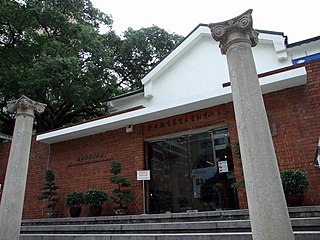
The Health Education Exhibition and Resources Centre opened on 17 May 1997 in Kowloon Park, Tsim Sha Tsui, Hong Kong. It is under the management of the Food and Environmental Hygiene Department of the Government of Hong Kong.
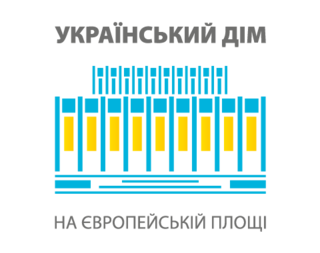
The Ukrainian House International Convention Center, is the largest international exhibition and convention center in Kyiv, Ukraine. The five-storey building is the host venue for a variety of events from exhibitions, trade fairs and conferences to international association meetings, product launches, banquets, TV-ceremonies, sporting events, etc.

The Khanenko Museum is an art museum located in Kyiv, in Ukraine, which holds the biggest and most valuable collections of European, Asian and Ancient art in the country.
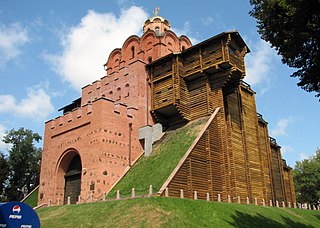
Ukrainian architecture has initial roots in the Eastern Slavic state of Kyivan Rus. After the 12th century, the distinct architectural history continued in the principalities of Galicia-Volhynia and later in Grand Duchy of Lithuania, Ruthenia and Žemaitia. During the epoch of the Zaporozhian Cossacks, a style unique to Ukraine developed under the influences of the Polish–Lithuanian Commonwealth.

The National Museum of the History of Ukraine illustrates Ukraine's history from ancient times till nowadays. It is one of the leading museums in Ukraine. It holds about 800 000 items in its collection, approximately 22 000 exhibits on permanent display. The museum holds world-famous archaeological, numismatic, ethnographic and weapons collections, pieces of decorative and applied arts, manuscripts, prints, paintings and graphics, relics of the Ukrainian national liberation movement of the 20th century.

Yuri Kosin was a Ukrainian photographer, lecturer, curator of exhibitions, and traveler. Kosin was a member of the National Society of Photo Artists of Ukraine, tutor and curator at the Independent Academy of the Photographic Arts of Ukraine, organizer and curator of the "Eksar" photo gallery, Ukraine. He was also a member of the "Kulturforum" association and the artistic studio "Kulturwerkstatt Trier", Germany. He was a permanent member of the TV Ukrainian program "Svoimi ochima" (eyewitness) dedicated to travel and tourism. Kosin was named one of the experts in photography criticism in Ukraine in expert poll conducted in 2011 and was a participant of the Ukrainian New Wave.

Museums in Kyiv, Ukraine include museums of art, history, transportation, and religion. They constitute an important aspect of Kyiv's focus on knowledge, culture, and history.

Varvara Nikolovna Khanenko was the eldest daughter of the entrepreneur, sugar king, philanthropist and collector Nikola Tereshchenko. Home schooled, she was interested, like her father, in art. She was Bogdan Khanenko's wife.

The National University of Kyiv-Mohyla Academy Library is the library system of the National University of Kyiv-Mohyla Academy, one of the oldest universities in Ukraine, founded in 1615, closed in 1817 and revived in 1991. It is a key academic resource that supports the teaching, learning, and research goals of the university; its various materials can be accessed by students, scholars, and the general public. Almost 70% are books and periodicals, donated by individuals, institutions and organizations from around the world. Library is composed of several locations across the university campus.

